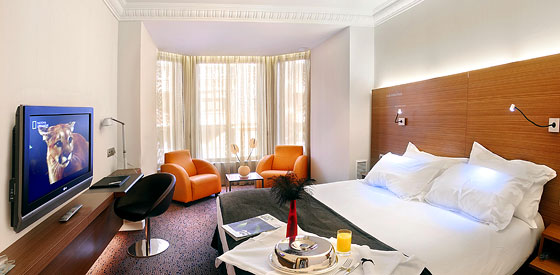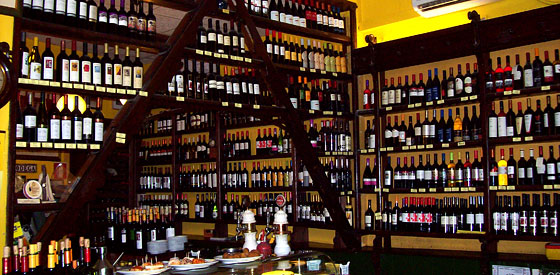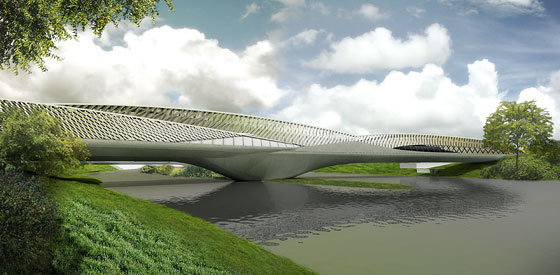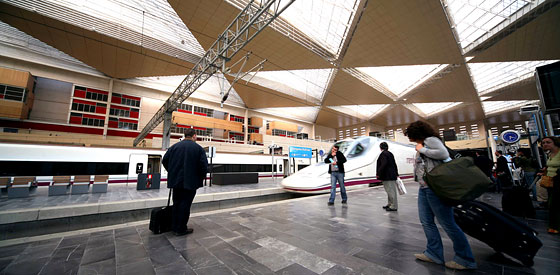1. Where to Stay

Board a glass elevator via the geometric black-marble atrium at Hotel Silken Zentro Zaragoza (from $200). The year-old, design-savvy hotel has stylish rooms with private balconies and boutique amenities like a pillow menu, flat-screen TV, and deluxe linens. Request a junior suite for more space and check your e-mail under an enormous abstract painting in the ground-floor bar.
The stately, five-story NH Gran Hotel (from $169), opened by King Alfonso XIII in 1929, boasts a crown-molded rotunda looming over an elegant cocktail lounge. Upstairs, rooms are simple but large with polished-to-perfection hardwood floors and recently updated bathrooms. Just around the corner, go shopping on fashionable Paseo de la Independencia.
Hotel Palafox (from $135) earns its five stars with an indoor pool, gym, excellent restaurant, and 179 colorful, contemporary rooms. For the most space, book the 700-square-foot Pignatelli suite, which has two bedrooms with private living room. Indulge in a well-edited selection of whiskeys at the hotel bar or grab a drink at a nearby bar—you’re right in the city center.
2. Where to Eat

For unbeatable tapas, get a table at Bodegas Almau (Calle de Estebanes Estébanes 10; 34-976-29-98-34), a family-owned tavern dating back to 1870. The house specialty is rich and piquant sardines on crusty bread and bowls of tangy olives paired with a glass of local Garnacha. Pair with any of the floor-to-ceiling stacks of wine representing almost every region and variety in Spain.
The exclusive Aragonia Paradis, located at the Palafox Hotel, has an equally impressive wine collection (they carry 800 varieties) and traditional Aragonese cuisine. Order the tender ternasco asado, lamb roasted for a glacial eighteen hours, while taking in the cream-colored, Pascua Ortega–designed dining room.
A Zaragoza fixture set on a bustling street in the center of town, Antiguo Tabernillas serves a menu heavy on excellent Spanish seafood in a refined atmosphere. Request a cozy banquette and order the simple but delicious grilled lenguado or succulent medallions of monkfish.
3. What to Do

Once home to Romans, Iberians, Jews, Muslims, and Christians, Zaragoza has an eclectic history best told by its buildings. The fifteenth-century La Seo cathedral (Plaza Ntra. Sra. Del Pilar 16, 34-976-201-953) combines Romanesque, neoclassic, and Moorish architecture—the latter is seen in the geometric brickwork and dazzling mosaics of the façade. Across the Plaza del Pilar, Basilica of Our Lady of the Pillar houses frescoes by a young Goya as well as a five-foot jasper and silver column marking the spot where the Virgin Mary is believed to have spoken to St. James in 40 C.E.. A few blocks east is the Caesaraugusta Theater Museum (Calle San Jorge 12; 34-976-20-50-88), an ear-shaped ruin and adjoining museum of first-century Roman theater.
Marvel at Moorish architecture at La Aljaferia (Calle de los Diputados; 34-97 6-28-96-85), a gargantuan, fortified palace begun by the Arab dynasties in the eleventh century. Take a guided tour of its filled-in moat and gardens and hear about its storied past as home to the Catholic kings, Ferdinand and Isabella, and the court of the Inquisition. Note the delicately carved mosque, ornate throne room, and Troubadour’s Tower—the oldest remaining part of the palace and also the inspiration for Verdi’s opera Il Trovatore.
See architectural wonders from the future at the International Expo 2008. From June 14 through September 14, 106 countries will showcase cultural and technological innovations in “Water and Sustainability” on a 62-acre, $1.25 billion site. For ultimate wow factor, visit the partially submerged River Aquarium (the largest in the world); starchitect Zaha Hadid’s Bridge Pavilion, a two-story spiraling footbridge and water exhibit; and Enrique de Teresa’s translucent, water-drop-shaped Water Tower. To take it all in in relative peace, take advantage of the Expos’$2 2 a.m. closing time.
4. Insider’s Tip

Entry to the Expo is a not-cheap 30.80 euros ($47.89), but if you go through the ZaragozaCard Website, admission price includes a 24-hour pass to the city’s clean, safe public-transportation system. Better yet, the card also grants access to free guided walks, bus tours, entry to most of the city’s museums and attractions, and discounts at local tapas restaurants and coffee bars. Or spring for a three-day pass and Expo entry for 61.60 euros ($95.78).
5. Oddball Day

Escape the Expo crowds with a day trip in Aragon’s history-rich countryside. Rent a car from the airport, (Avis, Hertz, or Europcar), and head 27 miles south on the N-330 highway to Goya’s picturesque hometown, Fuendetodos. Tour Casa Natal de Goya (Calle Zuloaga 3; 34-976-14-38-30), the simple stone house where the master was born, then walk a few doors down to the Engraving Museum (3 euros for both), where his famed series of prints, The Absurdities, Bullfighting, The Caprices, and The Disasters of War, hang. Next, walk streets ruined by the Spanish Civil War in Belchite, twelve miles east off A-220. Reduced to rubble during the war, the town rebuilt around the bombed-out homes and churches, leaving an eerie monument to the destruction. For a pick-me-up on the way back to town, have dinner at La Rebotica in Cariñena, a pharmacy turned family-run eatery about 40 minutes from Belchite heading west on A-220 (Calle San José 3, 34-976-62-06-56). The locally sourced, traditional menu boasts a surprisingly delicious blood-sausage lasagne and platters of paper-thin slices of Teruel ham, served by hospitable owner Silvestre Cros.
6. Links
Aragon Guide has handy walking guides to city sites and modernist architecture.
Take a virtual tour of the Expo site on YouTube.
Check out TrekEarth’s Zaragoza photo archive to get a better idea of which sites to prioritize.